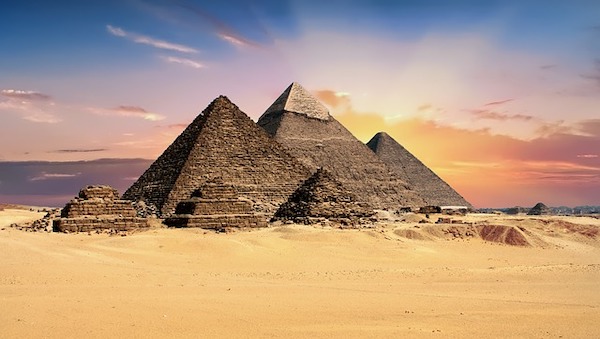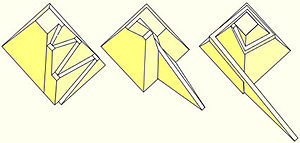From the Archives: Ramps, Allium & Google

My good friend Jeff Mann, the true Yard Ramp Guy, has asked me to revisit some of my original contributions. And so: my From the Archives series. Back now to ramps, one of my favorite inventions...

Wild Leeks
You know the first thing I see when I Google "ramps"? (Ignoring those constant ads, of course). A Wikipedia article on ramps. It's a pretty well researched and detailed article, too, listing all sorts of uses for ramps, their discovery and history, even festivals dedicated to them!
The only problem, though, isn't about inclined planes. It's about a plant. Specifically: Allium tricoccum, also known as wild leeks.
So when you Google one of the most important inventions in human history—one of the basic simple machines that makes civilization work—you get a smelly weed that some people like to eat. Maybe it's just me: I think the invention that allowed us to build the pyramids is a little more important than a backyard pest that makes food smell like old socks.
At least if you search on Wikipedia itself, inclined planes are the first thing to pop up. Whoever runs that site seems to know what they're doing, unlike those culinary-minded dudes at Google. It's all that time inside, I'm telling you. It's not healthy. You need fresh air and sunlight every day, so you don't end up drooling over random greenery from your yard.

That's me, thinking about ramps.
And no, this rant wasn't inspired by the new diet Maggie is putting me on. It's a legitimate complaint. I mean, I don't mind cutting back on red meat even more. I like fish and poultry just fine. I hardly drink more than a beer or two anymore, and I've been watching my cholesterol since my bypass 15 years ago.
I really just think that it's not going to hurt me to eat proper vegetables you find in the grocery store, not expensive health food store stuff I could pull out of my neighbor's yard.
(The one without the dogs, at least. Nice dogs, but I'm not eating anything out of that yard.)
That's not the point, though. I just think that Google is doing inclined planes a real disservice.
The Yard Ramp Guy®: Success in Yard Ramp Industrials
This week, my friend The Yard Ramp Guy's big wheels keep on turning with a great riff on the importance of attention to detail.
Dig into the specifics HERE.

From the Archives: Pyramids and Ramps

I've been composing this blog since July of 2014. That's five years and 151 entries. My good friend Jeff Mann, the true Yard Ramp Guy, has asked me to revisit some of my original contributions. And so: my From the Archives series. Fitting, then to start from the very beginning, with my very first entry...
The pyramids are among the wonders of the ancient world for a pretty simple reason: they're huge. Doesn't take much to figure that one out. But what got me interested in the pyramids in the first place was their construction.
 The ancient Egyptians obviously didn't have the technology for moving heavy loads that we did. All they had were a few primitive cranes, some basic levers and rollers, and, of course, ramps.
The ancient Egyptians obviously didn't have the technology for moving heavy loads that we did. All they had were a few primitive cranes, some basic levers and rollers, and, of course, ramps.
The old idea about how the Egyptians built the pyramids involved thousands of slaves hauling blocks up huge straight ramps to the top. It looks cool in the movies, but it doesn't actually work that well. The amount of material and labor needed to construct straight ramps to the top—and to continue building them up as the pyramid grows—is pretty close to the amount you'd need to build the actual pyramid itself, not to mention that they haven't actually found any evidence for ramps that colossally huge. Building ramps that huge, I say, is just a waste.
 It seems more likely that they instead either zigzagged the ramp up one side or spiraled it around the pyramid, using uncompleted segments as the ramp. This would have allowed them to construct the vast majority of the pyramid easily, though the top third of the structure would have needed to be moved up, using levers. Since it's so much narrower at the top, though, that top third makes up less than five percent of the total weight of the pyramid. That's working smart.
It seems more likely that they instead either zigzagged the ramp up one side or spiraled it around the pyramid, using uncompleted segments as the ramp. This would have allowed them to construct the vast majority of the pyramid easily, though the top third of the structure would have needed to be moved up, using levers. Since it's so much narrower at the top, though, that top third makes up less than five percent of the total weight of the pyramid. That's working smart.
Historians and archaeologists also think that rather than huge hordes of slaves, the pyramids were constructed by smaller teams of well-paid skilled laborers, who were cheaper than feeding an army of slaves and got things done much quicker. No one's said anything about ancient Egyptian unions, but I've got some cheerful suspicions about that.
The Yard Ramp Guy®: Planned Industrial Longevity
This week, my friend The Yard Ramp Guy makes a Ramp Rules-worthy connection between Greta Garbo's perfume and industrial yard ramps.
Sniff it out it HERE.

Whipple Shielding
Preventing Satellite Debris

Space Junk
In 2013, director Alfonso Cuarón came out with Gravity, a movie about junk. Specifically, it's a movie about space junk.
In the film, a missile strike on a satellite results in a runaway chain reaction of collisions between space junk and satellites. This brings down space stations, satellites, and spacecraft left and right, rendering Earth's orbit useless to manned travel.
Gravity is an excellent movie, and we’ll forgive a few scientific inaccuracies, since they're all in service of the plot. (Neil Degrasse Tyson, despite his multiple criticisms of the science, is a fan of the film.)
The threat in Gravity is a very real one. It's a scenario known as Kessler Syndrome, where space debris collides with space debris, generating more space debris, which collides with yet more space debris, until that specific orbit around Earth is so filled with debris that it is rendered nearly useless for human purposes. (Low Earth orbit is the most likely orbit to be lost to this process, though geosynchronous orbit is another possible victim.)
It's not astonishing that this is a serious concern for NASA and other space scientists. There are more than 2,000 satellites in orbit, about 1,500 of which are operational, along with nearly 18,000 trackable artificial objects.
Smaller objects are even more common—at least 29,000 chunks of debris in orbit that are more than 10cm in size, nearly 700,000 between 1-10cm in size, and 170 million chunks of debris below 1 cm in size.
Even with how spacious Earth's orbit is, there's a very high chance of impact, and at least one satellite is destroyed by debris every year. Space junk is a serious threat even if it doesn't trigger Kessler Syndrome.
Steps are being taken to combat the risk. We're tracking debris much more carefully than ever right now. The International Space Station and other spacecraft have special protective layers known as Whipple shield: instead of building hulls out of thicker material, engineers add an extra thin layer some distance over the regular hull. The layer isn't meant to stop the debris but to break it into smaller chunks. In essence, Whipple shield turns debris from a bullet into birdshot. It even makes the needed thickness for the inner hull much smaller, so overall spacecraft mass is actually reduced.
And this: we’re developing a technology known as a laser broom. Targeting a laser on debris will heat up one side of the debris. The resulting heat emissions will then alter and destabilize the debris' orbit, causing it to burn up in the atmosphere.
Like me, trying to make pizza.
The Yard Ramp Guy®: Appreciating U.S. Industry
This week, my friend The Yard Ramp Guy describes some select industries through a prism of how his yard ramps contribute:
Discover it HERE.

Mapping the World
The Ortelius Theatrum

The world map from Theatrum Orbis Terrarum
These days you don't see atlases very often. Google Maps are just much more prevalent and often more useful. Atlases are unquestionably a direct ancestor of Google Maps, however. The oldest ever atlas? The Theatrum Orbis Terrarum, or “Theatre of the World.” (Sorry, no Greek mythology jokes for you today.)
Originally published in May 1570, Theatrum Orbis Terrarum, was written by the mapmaker Abraham Ortelius (my favorite Brabantian). It contained a total of 53 maps, all bound together. Despite being a skilled mapmaker himself, all the maps included were from other mapmakers. (Though he frequently tidied them up a bit.)
Unusually for the time, Ortelius actually credited all 33 mapmakers in the bibliography. He also included a list of other quality mapmakers he knew in the back, which grew longer with every edition published during his lifetime.
Ortelius published 25 editions in his lifetime, the last of which contained 167 maps and was published in seven different languages. Naturally, I hold much admiration for someone who devoted such time and painstaking care to improve on such a singular undertaking. I’d like to think that Maggie thinks of my work on, say, the lawn, with such approval. Though Maggie might say otherwise.
(Confirming: Maggie just said otherwise.)
Theatrum Orbis Terrarum was hugely significant. Not only was it vital in pushing forward the navigational feats of the Age of Exploration, it also is considered to be the starting point for the Dutch Golden Age of Cartography, which lasted a solid century.
The maps included in Theatrum Orbis Terrarum were remarkably accurate for their time. Possibly even more importantly, it made geography accessible to the growing middle classes at the time, who hadn't been able to easily afford maps before this.
It massively improved the state of public education at the time, and made the world a more understandable and less mysterious place. That’s a good thing, right?
The Yard Ramp Guy®: Angling Ramps Into Warehouses
This week, my friend The Yard Ramp Guy follows the flow of warehouse scenarios and eloquently shows that many of those streams run through yard ramps.
Check out his great piece HERE.






